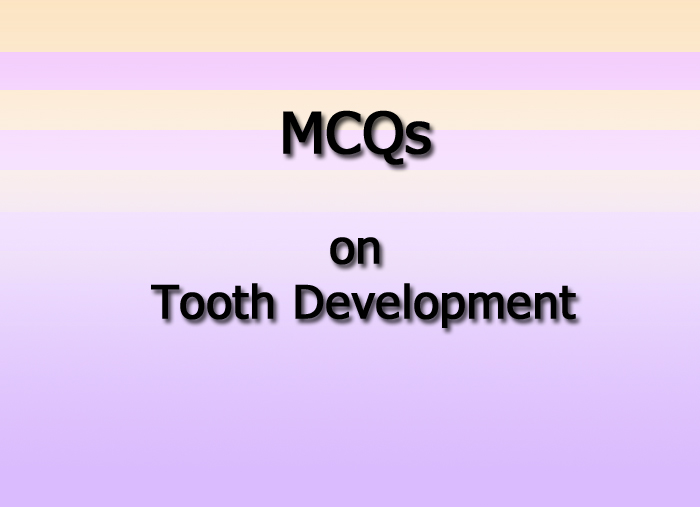- NEED HELP? CALL US NOW
- +919995411505
- [email protected]

1. Which of the following statement is correct?\
A. Enamel cannot form in absence of dentin
B. The formation of enamel and dentin are independent of each other
C. Enamel formation can occur in absence of dentin
D. None of the above
Answer:A
• Formation of dentin occurs first along the future dentinoenamel junction in the region of future cusps and proceed pulpally and apically
• After the first layer of dentin is formed, the ameloblasts lay down enamel over the dentin in the future incisal and cuspal areas
2. Dental lamina is active up to_______?
A. 1 year
B. 2 years
C. 3 years
D. 4 years
Answer:D
3. Ectodermal cells in tooth bud are responsible for_______?
A. Determination of shape of crown and root
B. Formation of periodontal ligament
C. Formation of cementum
D. Formation of pulp
Answer:A
4. Hertwig’s epithelial root sheath is made up of_______?
A. Outer and inner enamel epithelium
B. Stratum intermedium
C. Stellate reticulum
D. Hyaline layer of Hopewell-smill
Answer:A
• The cervical portion of enamel organ gives rise to hertwig epithelial root sheath (HERS)
• This HERS outlines the future root & thus responsible for the size shape and length & number of roots
• The enamel organ plays an important role in root development by forming HERS, which models the shape of the root
• HERS consists of outer & inner enamel epithelium only
• As the first layer of the dentin has been laid down, the epithelial root sheath loses its structural continuity and is close relation to the surface of the root
5. Following is derivative of dental lamina______?
A. Epithelial rests of Malassez
B. Enamel pearls
C. Rests of serres
D. All of the above
Answer:C
Fate of dental lamina
• Dental lamina is active for shorter duration
• Soon after tooth development starts the dental lamina starts degenerate
• In third molar region will be active till the age of 5 years
• As the tooth develops the connection breaks and islands of epithelial cell remain within the jaws and gingiva – “cell rests of serres”
6. Accessory canals result from______?
A. Defects in cementogenesis
B. Dividing epithelial bridges
C. Break in Hertwig’s root sheath
D. Adherent epithelial rests
Answer:C
7. Blood supply of ameloblast for most of its life cycle comes from_______?
A. Dental papilla
B. Reduced enamel organ
C. Dental Sac
D. Dental pulp
Answer:C
Dental sac or dental follicle: ectomesenchyme surrounding enamel organ and dental papilla
8. High levels of albumin is present in______?
A. Inner enamel epithelium
B. Outer enamel epithelium
C. Stellate reticulum
D. Stratum intermedium
Answer:C
Polygonal cells located between the outer and inner enamel epithelium, begin to separate due to water being drawn into the enamel organ from the surrounding dental papilla
• As a result the polygonal cells become star shaped but maintain contact with each other by their cytoplasmic process
• As the star shaped cells from a cellular network, they are called the stellate reticulum
9. In cap stage, regulating factor for cusp shape formation is present in______?
A. Dental papilla
B. Dental follicle
C. Inner enamel epithelium
D. Enamel Knot
Answer:D
• The cell in the center of the enamel organ are densely packed and form the enamel knot
• This knot projects towards the underlying dental papilla
• At the same time a verticle extension of the enamel knot called the enamel cord occurs
• They act as a reservoir of the dividing cell from the growing enamel organ
• Enamel knot acts as a signaling centers as any important growth factors are expressed by the cells of the enamel knot and thus play an important role in determining the shape of the tooth
10. Which of the following is not an ecto-mesenchymal derivative ?
A. Dentin
B. Cementum
C. Pulp
D. Enamel
Answer:D
Bell stage/ histodifferentiation
• Inner enamel epithelium: Single layer of cells that differentiates prior to amelogenesis into tall columnar cells called ameloblasts
• The cells of the inner enamel epithelium exert a strong influence on the underlying mesenchymeal cells of dental papilla which later differentiates into odontoblasts




